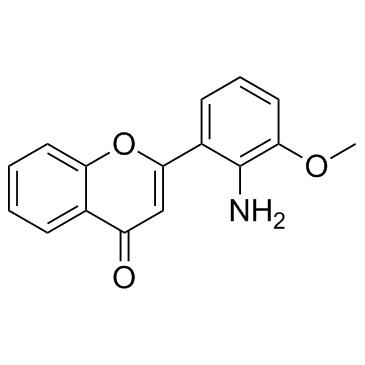PD98059

PD98059 structure
|
Common Name | PD98059 | ||
|---|---|---|---|---|
| CAS Number | 167869-21-8 | Molecular Weight | 267.279 | |
| Density | 1.3±0.1 g/cm3 | Boiling Point | 453.1±45.0 °C at 760 mmHg | |
| Molecular Formula | C16H13NO3 | Melting Point | 170 °C | |
| MSDS | Chinese USA | Flash Point | 221.9±25.0 °C | |
| Symbol |

GHS06 |
Signal Word | Danger | |
|
bFGF attenuates endoplasmic reticulum stress and mitochondrial injury on myocardial ischaemia/reperfusion via activation of PI3K/Akt/ERK1/2 pathway.
J. Cell. Mol. Med. 19(3) , 595-607, (2015) Extensive research focused on finding effective strategies to prevent or improve recovery from myocardial ischaemia/reperfusion (I/R) injury. Basic fibroblast growth factor (bFGF) has been shown to have therapeutic potential in some heart disorders, including... |
|
|
A novel imidazopyridine derivative, X22, prevents the retinal ischemia-reperfusion injury via inhibition of MAPKs.
Exp. Eye Res. 135 , 26-36, (2015) Inflammation is a pathological hallmark of ischemia reperfusion (I/R) injury. The present study was conducted to explore the ability of a new anti-inflammatory compound, X22, to attenuate retinal I/R injury via cytokine-inhibitory mechanism. For the in vitro ... |
|
|
CD38 expression in early B-cell precursors contributes to extracellular signal-regulated kinase-mediated apoptosis.
Immunology 144(2) , 271-81, (2015) CD38 is a 45,000 molecular weight transmembrane protein that is expressed in immature and mature lymphocytes. However, the expression and function of CD38 during B-cell differentiation in mice is poorly understood. Here, we report that CD38 is expressed from ... |
|
|
Orthovanadate-Induced Vasoconstriction of Rat Mesenteric Arteries Is Mediated by Rho Kinase-Dependent Inhibition of Myosin Light Chain Phosphatase.
Biol. Pharm. Bull. 38 , 1809-16, (2015) Orthovanadate (OVA), a protein tyrosine phosphatase inhibitor, induces vasoconstriction in a Rho kinase-dependent manner. The aim of this study was to determine the mechanism underlying OVA-induced vasoconstriction of rat mesenteric arteries. OVA-induced cons... |
|
|
Cyclosporine A induces connective tissue growth factor expression in human gingival fibroblasts: suppression by epigallocatechin-3-gallate.
J. Formos. Med. Assoc. 113(11) , 828-32, (2014) Transforming growth factor-β (TGF-β) plays an important role in the pathogenesis of cyclosporine A (CsA)-induced gingival overgrowth (GO). Connective tissue growth factor (CTGF/CCN2) acts as a cofactor with TGF-β to induce the maximal profibrotic effects of T... |
|
|
EPA-enriched phospholipids ameliorate cancer-associated cachexia mainly via inhibiting lipolysis.
Food Funct. 6 , 3652-62, (2015) Excessive loss of fat mass is considered as a key feature of body weight loss in cancer-associated cachexia (CAC). It affects the efficacy and tolerability of cancer therapy and reduces the quality and length of cancer patients' lives. The aim of the present ... |
|
|
Rapid CD4+ T-cell responses to bacterial flagellin require dendritic cell expression of Syk and CARD9.
Eur. J. Immunol. 45(2) , 513-24, (2015) Toll-like receptors (TLRs) can recognize microbial patterns and utilize adaptor molecules, such as-MyD88 or (TRIF TIR-domain-containing adapter-inducing interferon-β), to initiate downstream signaling that ultimately affects the initiation of adaptive immunit... |
|
|
Ubiquitin-like protein MNSFβ negatively regulates T cell function and survival.
Immunol. Invest. 44(1) , 1-12, (2014) Monoclonal non-specific suppressor factor β (MNSFβ) is a ubiquitously expressed member of the ubiquitin-like family that is involved in various biological functions. Previous studies have demonstrated that MNSFβ covalently binds to intracellular pro-apoptotic... |
|
|
Oncogenic Ras/ERK signaling activates CDCP1 to promote tumor invasion and metastasis.
Mol. Cancer Res. 12(10) , 1449-59, (2014) Involvement of Ras in cancer initiation is known, but recent evidence indicates a role in cancer progression, including metastasis and invasion; however, the mechanism is still unknown. In this study, it was determined that human lung cancer cells with Ras mu... |
|
|
Mutagenicity and tumor-promoting effects of Tiglium seed extract via PKC and MAPK signaling pathways.
Biosci. Biotechnol. Biochem. 79(3) , 374-83, (2015) Tiglium seed is a seed of mature Croton Tiglium Linne containing croton oils, which have been traditionally used as laxative or purgative. As it contains phorbol derivatives, we investigated the mutagenicity and tumor-promoting activity of Tiglium seed. Tigli... |